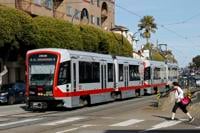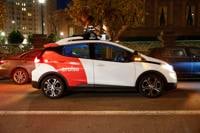A group of San Francisco startups could play key roles in helping keep the lights on amid the rush to electrify vehicles, homes and commercial buildings.
The move from gasoline-powered cars and natural-gas-powered appliances to electric ones is expected to add significant new demand to the power grid in coming years. WeaveGrid, Span, Voltus and Bidirectional Energy — all based in The City — are working on different ways to help handle the load.
“We’re going to be moving a lot more electrons during certain time periods than the current transmission and, certainly, distribution network is capable of doing, if we don’t do that smartly,” said Christopher Knittel, deputy director of policy at the MIT Energy Initiative, a research center at the Massachusetts university. “Technology is a potential solution to this. That’s what these startups are potentially offering to the grid.”
To avert the worst effects of climate change, California and the U.S. government under President Joe Biden are pushing to reduce the use of carbon-emitting fossil fuels by electrifying cars, stovetops, water heaters and more. Spurred on by subsidies, tax incentives and regulatory changes, that move toward greater electrification is expected to boost demand for electricity nationwide toward the end of this decade.
Estimates of just how much demand will increase vary widely. But the U.S. Energy Information Administration, a division of the Department of Energy, projects nationwide demand will grow by 1% a year from 2022 to 2050; at that rate, electricity demand would grow by 32% over that time period.
Solar energy will help address some of that demand, but not all of it. With the construction of new power plants and transmission difficult, costly and lengthy, many energy planners are starting to worry about how the electrical grid will deal with the excess load while still helping the country meet its goals to reduce greenhouse-gas emissions.
Enter the San Francisco startups, each of which is tackling the problem in a different way.
Voltus: making connections
Perhaps the best-established is Voltus, which launched in 2016. Led by CEO Dana Guernsey, Voltus connects utilities and wholesale energy providers in all the major electricity regions of North America with so-called distributed energy resources, or DERs.
Voltus, headed by CEO Dana Guernsey, offers utilities and grid operators on-demand power and reduced demand from everything from small-scale power generators to smart thermostats.
Courtesy of Voltus
DERs can include large battery systems that store electricity, small-scale power generators, smart thermostats or commercial building-management systems that can reduce power consumption on command. Voltus provides both the software and hardware to connect those systems to its service and, in turn, to grid operators and utilities.
Voltus’ utility and other customers pay it to provide power or reduce demand. The company then shares that money — or shares in the cost savings from reduced energy use — with DER operators.
The startup’s service helps to make up for the fluctuating power provided by renewable-energy sources such as wind and solar, Guernsey said. But Voltus also expects growing demand for its services as electricity usage increases due to EVs and electrification, among other things.
“We need to add more capacity because we are moving things into the electric sector that didn’t used to be [there],” Guernsey said. “We exist to make sure that that load growth can happen.”
WeaveGrid: Maximizing EV charging
Like Voltus, WeaveGrid is also working with utilities to help them address increased demand from electrification. But it’s focusing much more narrowly on just electric vehicles.
WeaveGrid’s software helps power companies manage customers’ EV charging so they don’t have numerous vehicles charging at once and overtaxing their grids. At the same time, it helps car owners ensure that they’re charging their vehicles when rates are low and clean energy is plentiful — while also making sure their cars are fully charged when they need them.
Founded in 2018, the 84-person company is working with nine of the 10 biggest utilities in the country, including PG&E, and several of the big automakers and charging networks, said CEO Apoorv Bhargava.
Bhargava and co-founder John Taggart decided to focus on EVs, because they represent a singular challenge, in terms of power demand, he said. The amount of power they require is much larger than that required by a heating and air-conditioning system — and, unlike those systems, they’re mobile, so they can tax the grid in different places at different times.
And with EV sales growing rapidly, the challenge faced by utilities and grid operators is likely to grow more and more acute — and to boost WeaveGrid’s sales, Bhargava said.
The electricity demand coming from EVs is “going to become really painful,” he said. “We’re seeing clients go through that pain already.”

All five candidates, between sips of their favorite boba tea order on stage, said they value the Asian American community and would work hard to support them and inclu…

Prop. L, which seeks to help close Muni’s yawning deficit, could fail even if it earns a majority of the vote due to a conflict with Prop. M

Officials with the National Highway Transportation Safety Administration said they will meet quarterly with officials from the autonomous-vehicle company over the next…
Span: in-home demand
Span also works with utilities, but it’s focused on the power demand inside individual homes and buildings, rather than across the grid. The 200-plus-person startup has developed a “smart” electrical panel that can throttle down the power going to particular uses during times of peak demand.
Traditionally, when a major new electrical appliance is added to a home — a heat pump, say, or an EV charger — the owner frequently has had to upgrade, at considerable cost, the electrical line coming into the house to ensure there’s enough power for all the appliances in the house, said Span CEO Arch Rao. But homes rarely need all that capacity, because people typically don’t have all their electrical appliances running at the same.
Span’s box helps homes avoid such upgrades and make do with lower-capacity connections. The smart panel can also help utilities avoid upgrading their transmission lines to accommodate higher-capacity connections to homes and can help home builders avoid having to put in place such connections to new houses, Rao said. Because of that, utilities such as PG&E are giving customers rebates to install Span’s box, he said.
The startup, which has raised $285 million since its founding in 2018, has shipped its devices to all 50 states and Puerto Rico, Rao said.

SPAN founder and CEO Arch Rao: “We reinvented the electrical panel to make it … easier for all of us as homeowners to make that switch.”
Craig Lee/The Examiner
The current infrastructure inside most homes doesn’t support the move toward greater electrification, he said.
“We reinvented the electrical panel to make it less expensive and easier for all of us as homeowners to make that switch towards a more electric-enabled lifestyle,” Rao said.
Bidirectional Energy: Versatile EVsLike Span, Bidirectional Energy is working on a narrow part of the electrification challenge. The two-person startup has developed software that will help electric-vehicle owners in coming years use their cars as big batteries that can power their homes or send electricity back to the grid.
An electric vehicle can store about five times as much electricity as a Tesla Powerwall battery storage system, said Angela Zhang, Bidirectional’s co-founder and CEO. Hooked to new kinds of chargers that can send power from a car to the grid as well as the other direction, EVs can become a kind of DER, providing utilities with a backup energy source in times of stress.
Bidirectional, which has raised about $2 million in venture funding, plans to offer an app that will notify car owners when the grid needs energy and plans to share with them the money the utilities will pay for that power. The startup estimates customers will make around $750 a year from sending power back to the grid from their cars.
The company’s system is still in the testing phase, but it plans to roll out a pilot project in California this spring, funded by a grant from the CEC.

Bidirectional Energy founder and CEO Angela Zhang: “[Our focus is to] have EVs … be part of the solution.”
Craig Lee/The Examiner
From talking to people in the electrical industry, Zhang said, she has heard a lot of concern about how EVs are going to affect an already stressed electrical grid.
Bidirectional’s focus is to “have EVs, instead of contributing to the load problems that our grid faces, to have it be part of the solution,” she said.
The hurdles to clear
Given that all four of the companies are startups, their long-term success is uncertain at best. Many startups — including those in San Francisco — are offering somewhat similar solutions.
Amid a difficult funding environment for all startups, many could have trouble finding the capital they need to keep growing. Voltus, for one, has already had some challenges. It made plans in 2021 to go public and raise additional funds via a merger with a blank-check company. But that deal fell apart the following year amid growing investor disfavor with such mergers.
After not raising cash since 2021, the all-remote company — which has about 10% to 15% of its staff based in the Bay Area — is pushing to reach profitability, Guernsey said.
Still, the broad challenge Voltus, WeaveGrid, Span and Bidirectional are working on is a real one and will likely need technological solutions, experts said. And it’s a good sign that some of these startups are signing partnership deals with big utilities, said Nicole Staple, vice president of growth at Rewiring America, a nonprofit that’s focused on promoting electrification efforts, particularly in low-income communities.
“That is a very positive sign that change is really coming and these utilities are trying to figure out how to make this work and which solutions are going to be the winners,” Staple said. “It’s all, honestly, a hugely optimistic signal.”
Copyright for syndicated content belongs to the linked Source link












